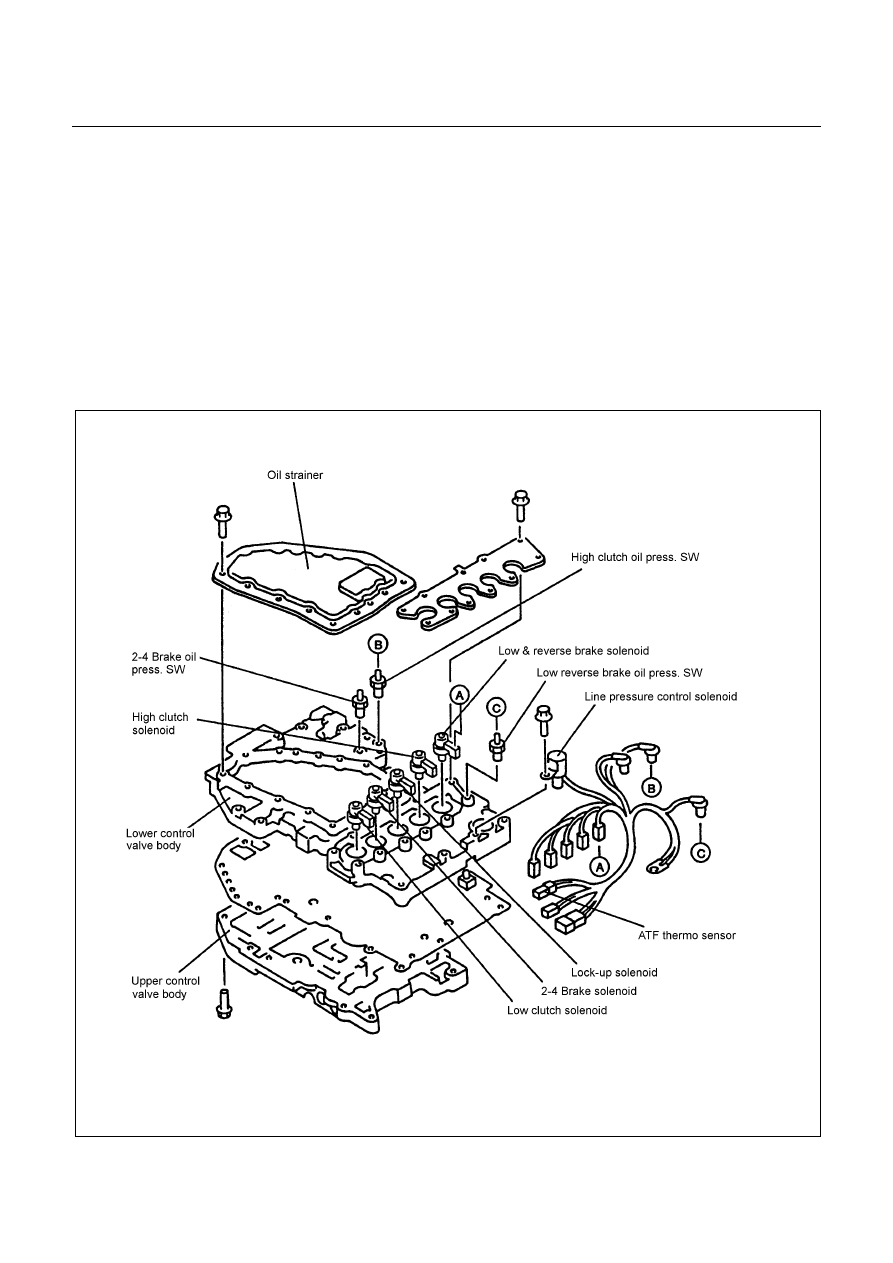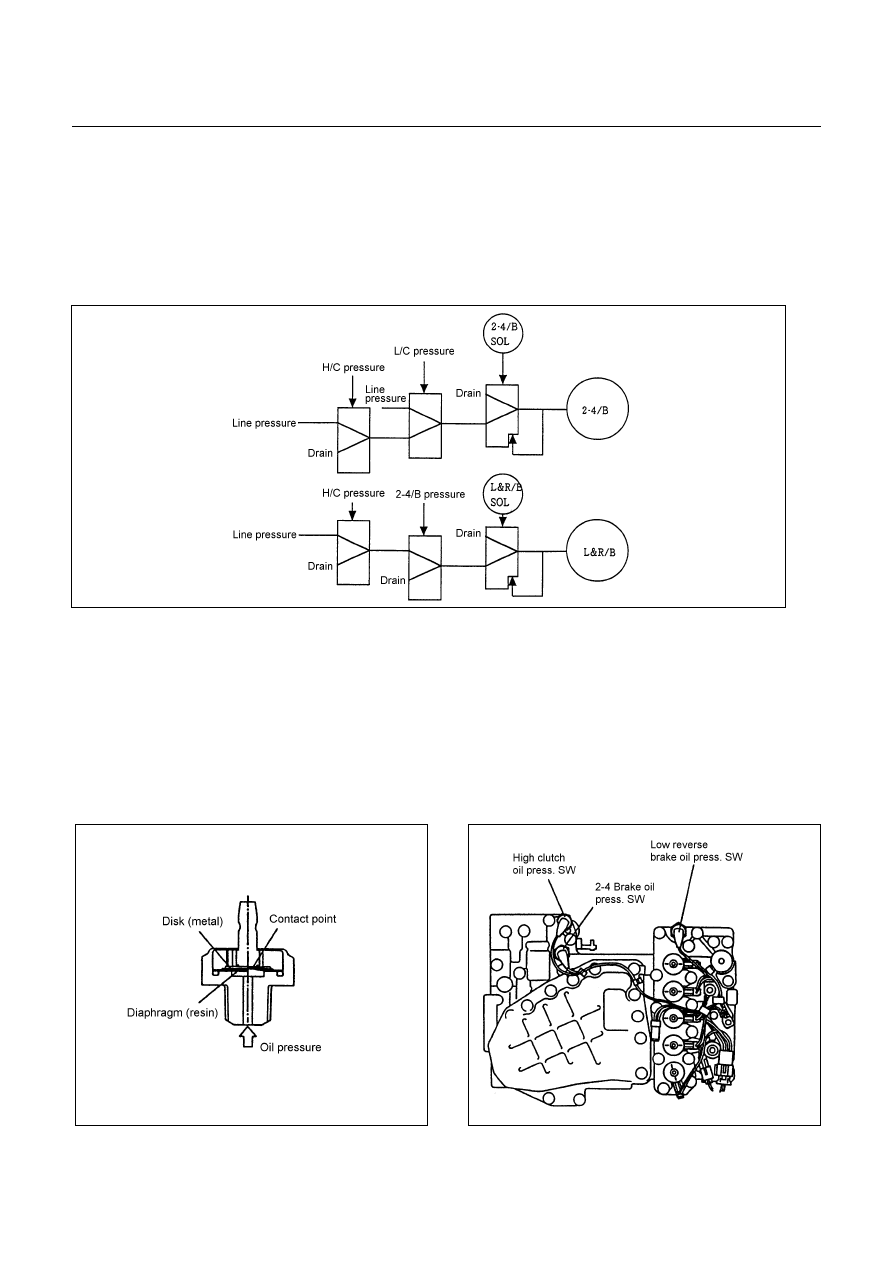Isuzu D-Max / Isuzu Rodeo (TFR/TFS). Manual — part 1729

CONSTRUCTION AND FUNCTION 7A1-13
2-4 Brake and Low & Reverse Brake (Multi-Plate Brake)
•
The multi-plate brake is composed of drive plates and driven plates. By applying the oil pressure onto
the end surface of the plates, the clutch is engaged or disengaged. The oil pressure is adjusted with the
control valve according to the signal from the TCM.
•
All brakes use dish plates to prevent uncontrolled operation of the clutches when engaged, causing a
shock.
•
The solenoid in the control valve is driven based on the speed change signal from TCM and moves the
shift valve, thereby engaging the drive plate and driven plate through the piston of each clutch.
•
Resultantly, rotation of each element of the planetary gear unit is fixed.
•
When the oil pressure is removed, the piston returns to the original position by the force of the return
spring.
Figure 19. Construction of 2-4 Brake
Figure 20. Construction of Low & Reverse Brake
Low One-way Clutch
•
The low one-way clutch employs the sprag which locks the counterclockwise rotation of the front planetary
carrier and rear internal gear.
•
The one-way clutch outer race is fitted with the low clutch drum and the inner race with the transmission
case.
•
The outer race rotates freely clockwise but, when it attempts to rotate counterclockwise, the sprag
functions to lock the outer race.
•
When the vehicle is traveling in 1st gear in the D, 3 or 2range, the low one-way clutch locks the rear
internal gear via the low clutch. It is left free in the 2nd, 3rd or 4th gear position.
Figure 21. Construction of Low One-way Clutch

7A1-14 CONSTRUCTION AND FUNCTION
CONTROL VALVE
•
Employing the direct electronic control (Direct Electronic Shift Control: DESC) for the clutch pressure has
simplified the oil pressure circuit, reduced the number of functional components and made the control
valve compact.
•
The control valve body is divided into the upper body and lower body. All solenoids, oil pressure switch
and ATF thermo sensor are installed to the lower body.
•
Three-way valve type solenoids providing high responsibility are employed. Some of the solenoids are
switched between ON and OFF and others repeat ON and OFF at 50Hz (duty cycle system).
Functionally, some supply output pressure when power is not supplied and others drain the output
pressure.
•
When the solenoid is driven based on the signal from the TCM, the oil pressure is changed. The valve is
operated by the difference of the oil pressure.
Figure 22. Construction of Valve Body

CONSTRUCTION AND FUNCTION 7A1-15
Line Pressure Solenoid
•
The line pressure solenoid is turned ON or OFF according to the signal from the TCM. It switches the
line pressure between high and low pressure.
•
While no power is supplied, the solenoid supplies high pressure.
Shift Solenoid
•
The shift solenoid is of the duty cycle type which are turned ON or OFF at 50Hz. The ratio of the ON and
OFF time can be freely controlled in the range of 0 - 100%.
•
While no power is supplied, the solenoid supplies output pressure.
•
The low clutch solenoid adjusts the low clutch pressure, the high clutch solenoid the high clutch pressure,
the 2-4 brake solenoid the 2-4 brake pressure and the low & reverse brake solenoid the low & reverse
brake pressure respectively.
Lock-up Solenoid
•
The lock-up solenoid is of the duty cycle type which is turned ON or OFF at 50Hz. The ratio of ON and
OFF time can be freely controlled in the range of 0-100%.
•
While no power is supplied, the solenoid drains the output pressure.
Figure 23. Shift Solenoid
Figure 24. Lock-up Solenoid
Figure 25. Location of Solenoid

7A1-16 CONSTRUCTION AND FUNCTION
Control Valve Fail-safe Function
•
To prevent interlocking due to engagement of more than three clutches and brakes at the same time, the
2-4 brake fail-safe valve A and B, and the low & reverse brake fail-safe valve A and B are provided.
•
When oil pressure is generated in the high clutch and the low clutch, the 2-4 brake solenoid is turned ON
to drain the oil pressure applied to the 2-4 brake.
•
When oil pressure is generated in the high clutch or 2-4 brake, the low & reverse brake solenoid is turned
ON to drain the oil pressure applied to the low & reverse brake.
Figure 26. Fail-safe Function
Oil Pressure Switch
•
The oil pressure switch detects the oil pressure supply condition to the clutch and brake and sends the
detection result to the TCM.
•
The oil pressure switch is turned ON when the oil pressure reaches the switch working pressure and
turned OFF when the pressure decreases below the specified value.
•
The high clutch oil pressure switch detects the high clutch oil pressure, 2-4 brake oil pressure switch the
2-4 brake oil pressure, and the low & reverse brake oil pressure switch the low & reverse brake oil
pressure respectively.
Figure 27. Oil Pressure Switch
Figure 28. Location of Oil Pressure Switch

Нет комментариевНе стесняйтесь поделиться с нами вашим ценным мнением.
Текст